Nanoxia Deep Silence 4
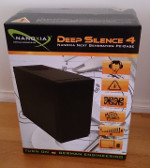
Introduction
I came across the Nanoxia Deep Silence 4 when looking for a case for my new PC build, the Nanoxia Deep Silence 4 is a robust Micro ATX computer case designed for quiet operation. I had not previously heard of Nanoxia but after some research found that they had a good reputation for building quality cases and were often compared to Fractal Design for building elegant cases.
At the time I purchased the Nanoxia Deep Silence 4 (Dec. 2013) there were not many reviews to the case only general media release information to say that the case was now available - hence I decided to write a review to provide further information and feedback on the case.
Overview
The Nanoxia Deep Silence 4 case is strong, robust and very solid. The majority of the case is constructed from steal with plastic used at the front.

The side panels are fitted in the traditional way, slide on from the rear, and are held in place via 4 thumb screws 2 on each side. Both side panels have noise dampening material on the inside to reduce noise.
The case can accommodate Micro ATX, or Mini ITX motherboards and there are 4 expansion slot cut outs at the rear of the case.
The front IO are located at the top of the case, there are 2 audio jacks (headphone & microphone), power button (with a green ring LED for power and an integrated red LED which blinks for HDD activity), 2 x USB 3 & 1 USB 2 ports.
The top half of the front panel is a door which covers the 2 x 5.25 external drive bays as well as 2 x fan controllers (each able to control 3 fans), the reset button is also behind the front door The front door also has sound dampening foam to help reduce noise.
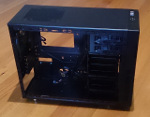
The front fan is located behind the lower half of the fixed front panel, there are air inlet slots at the bottom and sides of the front bezel. Although there is not door for the bottom half of the front cover the front fan and dust filter can be accessed by removing the front bezel.
There are positions for 3 fans, a front and rear 120mm fan are included and there is room for an additional 120mm or 140mm fan at the top rear of the case. The optional top rear fan location comes with an internal cover to reduce noise when not used but can easily be removed if you with to mount an additional fan.
As there is room for only 3 chassie fans I think it's a little odd that there are 2 fan controllers each capable of driving 3 fans for a total of 6 fans which could be controlled by the integrated fan controllers. So this seems somewhat overkill but I guess it allows users to put different fans on different controllers and hence have 2 different settings. In my build I did not use the fan controllers at all and just used the fan headers on the motherboard.
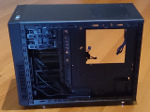
There is no bottom fan which I thought was a bit of a pitty, I think they could have placed a bottom fan location between the power supply and HDD, there already screw holes in that location to mount a SSD to the bottom of the case but I think this area could be dual purpose and include a cut out and mounting holes for a fan as another option. It might also depend on how long the PSU is, I have a shorter 140mm PSU as opposed to a standard length 160mm PSU, with this setup I think a bottom fan would be possible. Also the bottom PSU dust filter could just be extended and thus also provide a dust filter for the bottom fan if one was mounted.

The interior of the case is quite well laid out and has well located cut outs and enough room behind the motherboard tray to allow good cable routing. There are also a number of fastening points which allow you to zip tie cables to the case and hold them in place.
The PSU is mounted at the bottom rear on the case and there are 4 rubber feet for the PSU to sit on - again to prevent vibrations and noise from the PSU. There is a air intake on the bottom of the case which is covered with a removable dust filter which slides out the back from under the case.
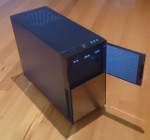
There are 6 2.5/3.5 internal drive bays, top removable cage holds 3 bays, mid removable cage contains 2 bays and there is a fixed 1 bay at the bottom. HDD/SSD are monuted with screws into carriages then slid into the bays. The carriages have mounting holes to suit both HDDs and SSDs and there are rubber grommets on the HDD mounting holes to reduce vibration from mechanical drives. There is also 1 additional location to mount a SSD, an SSD can be mounted to the bottom of the case between the PSU and HDD cages.
The removable HDD cages provide flexibility for different PC builds. Unused HDD cages can be removed for improved airflow from the front fan, for allowing longer graphics cards (up to 395mm), or for installing a 120mm radiator at the front if you choose to.
The included Nanoxia accessories are very good, there is 5.25" to 3.5" converter and face plate if you choose to install a card reader, as well as zip ties, motherboard stand-offs, and all required screws. Oh and the manual is quite good and is even pictures in colour as apposed to black and white.
Specifications:
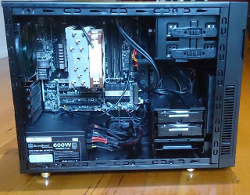
| Model | Deep Silence 4 |
|---|---|
| Case Type | Mini Tower |
| Form Factor | Micro-ATX, Mini-ITX |
| 5.25 inch drive bay external | 2 x |
| 3.5 inch drive bay external | 1 x (optional) |
| 2.5/3.5 inch drive bay internal | 6 x 2.5/3.5" + 1 x 2.5" |
| Case Fan (Front) | 1 x 120 mm (1,300 rpm) |
| Case Fan (Rear) | 1 x 120 mm (1,300 rpm) |
| Case Fan (Top) | optional 1 x 120/140 mm |
| Dimensions | (H)380mm x (W)200mm x (D)480mm |
| Material | steel, plastic |
| Weight | 7.8 kg |
| Maximum installation height of CPU coolers | 160mm |
| Maximum VGA Card Length | 265mm (395mm with HDD cage(s) removed) |
Conclusion
The Nanoxia Deep Silence 4 Micro ATX case is a well built and solid case. It offers good features and flexibility for PC builds and is reasonably priced. The noise reducing features ensure the case is whisper quiet, and aesthetically I think it looks good. It's a sleek, quiet, quality case.
Pros:
- Build quality - solid and strong
- Flexibility - removable HDD cages, good cable routing options
- Quiet - at idle you can't tell if its on or off
- Aesthetics - looks good, nice front IO and door
Cons:
- No bottom fan? - not really needed

